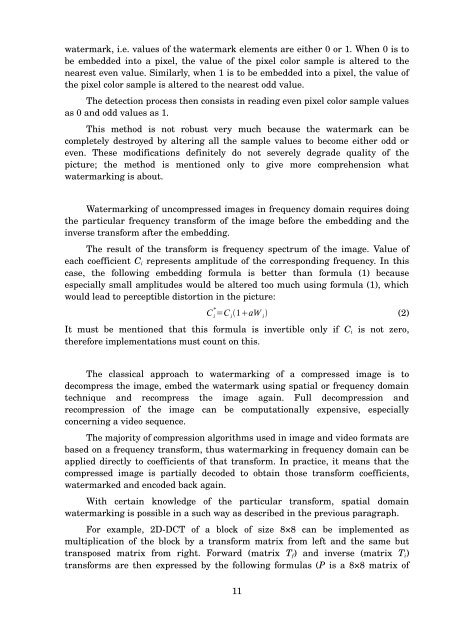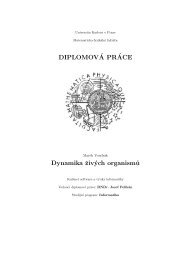MASTER THESIS Video Watermarking - Computer Graphics Group ...
MASTER THESIS Video Watermarking - Computer Graphics Group ...
MASTER THESIS Video Watermarking - Computer Graphics Group ...
Create successful ePaper yourself
Turn your PDF publications into a flip-book with our unique Google optimized e-Paper software.
watermark, i.e. values of the watermark elements are either 0 or 1. When 0 is to<br />
be embedded into a pixel, the value of the pixel color sample is altered to the<br />
nearest even value. Similarly, when 1 is to be embedded into a pixel, the value of<br />
the pixel color sample is altered to the nearest odd value.<br />
The detection process then consists in reading even pixel color sample values<br />
as 0 and odd values as 1.<br />
This method is not robust very much because the watermark can be<br />
completely destroyed by altering all the sample values to become either odd or<br />
even. These modifications definitely do not severely degrade quality of the<br />
picture; the method is mentioned only to give more comprehension what<br />
watermarking is about.<br />
<strong>Watermarking</strong> of uncompressed images in frequency domain requires doing<br />
the particular frequency transform of the image before the embedding and the<br />
inverse transform after the embedding.<br />
The result of the transform is frequency spectrum of the image. Value of<br />
each coefficient Ci represents amplitude of the corresponding frequency. In this<br />
case, the following embedding formula is better than formula (1) because<br />
especially small amplitudes would be altered too much using formula (1), which<br />
would lead to perceptible distortion in the picture:<br />
<br />
It must be mentioned that this formula is invertible only if Ci is not zero,<br />
therefore implementations must count on this.<br />
The classical approach to watermarking of a compressed image is to<br />
decompress the image, embed the watermark using spatial or frequency domain<br />
technique and recompress the image again. Full decompression and<br />
recompression of the image can be computationally expensive, especially<br />
concerning a video sequence.<br />
The majority of compression algorithms used in image and video formats are<br />
based on a frequency transform, thus watermarking in frequency domain can be<br />
applied directly to coefficients of that transform. In practice, it means that the<br />
compressed image is partially decoded to obtain those transform coefficients,<br />
watermarked and encoded back again.<br />
With certain knowledge of the particular transform, spatial domain<br />
watermarking is possible in a such way as described in the previous paragraph.<br />
For example, 2D-DCT of a block of size 8×8 can be implemented as<br />
multiplication of the block by a transform matrix from left and the same but<br />
transposed matrix from right. Forward (matrix Tf) and inverse (matrix Ti)<br />
transforms are then expressed by the following formulas (P is a 8×8 matrix of<br />
11<br />
(2)
















